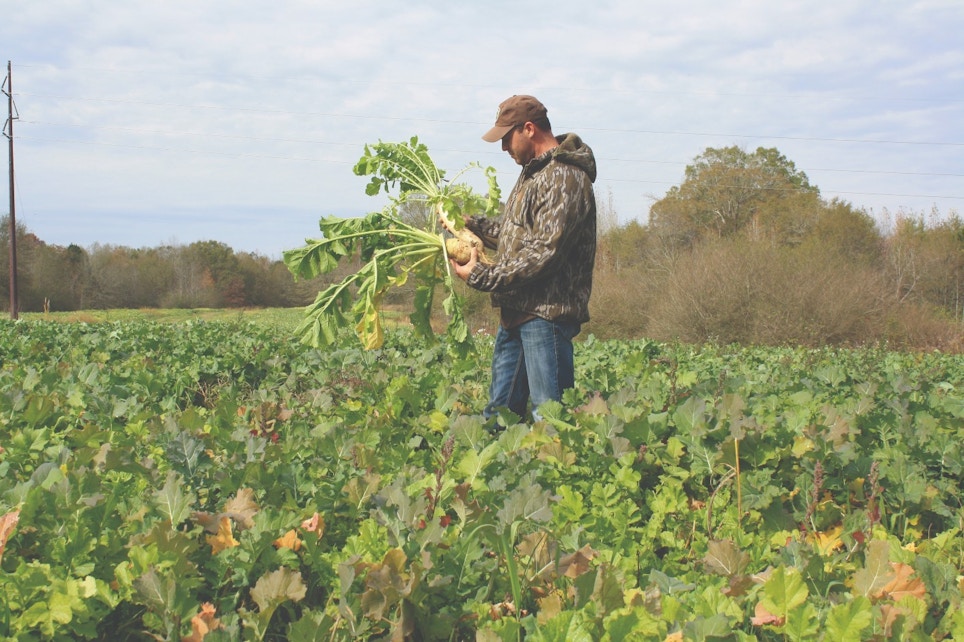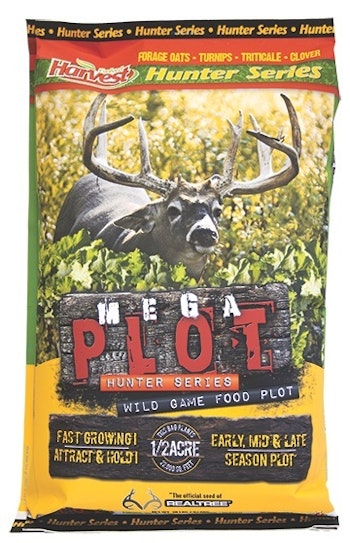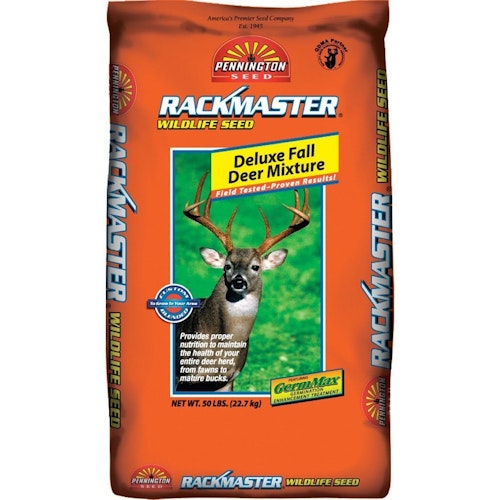Deer hunters like to use a variety of methods to pull more deer onto their hunting lands and keep them there during the season. One of the most effective — and laborious, I might add — is planting food plots of a variety of different plants that deer can’t resist.
As a little “Food Plot 101” type info, food plot planting for deer and other wildlife falls into two main categories: warm-season and cool-season. Warm-season plantings are typically planted in spring and grow throughout the summer and into fall. They include forages like soybeans, corn, sorghum, cowpeas and other agricultural type crops. Interestingly, some clovers, though often considered cool-season forages, are very versatile and can be used for either spring or fall planting. Not only does high-protein clover attract deer, but it also gives them excellent nourishment and even helps bucks grow bigger antlers.
Cool-season forages are planted in the fall or early spring, and some grow throughout the year. They include forage plants like wheat, rye, oats, clovers and brassicas. Deer love brassicas, which are easy to establish, grow quickly and are suited for growing in a wide variety of climates and soil types. Most cool-season forages are perennials, meaning they will come back again the following year after planting, but some are not.
Creating a good food plot is a multi-step process. First, hunters must locate a spot on their hunting property that is the appropriate size and in a desirable location to provide deer with a food attractant. To prepare the area, hunters must first mow, spray, or mow and spray the area to clear it of its current vegetation. Next, the ground must be broken up to allow for good seed-to-soil contact. At this time, a soil sample should be taken so any necessary fertilizers can be added. Next, an adequate supply of seed must be purchased, then spread in the correct manner and amount. Finally, with all that done, it’s time to pray for rain.
Let’s take a look at three high-quality seed blends for hunters looking to plant productive food plots — and for retailers to carry in their inventory to sell to those hunters. For this column, we’ll look at cool-season mixes that are typically planted in fall and hunted over during the fall and winter.
Mossy Oak Biologic Green Patch Plus
Biologic has been offering seed blends for many years, and hunters throughout the nation have benefitted from the plots made with their top-quality seed blends. Green Patch Plus is one of the company’s more popular mixes and grows well from northern Michigan to deep south Texas.
Green Patch Plus is a fall plot planting that combines the proven attractiveness of transitional grains with the well-known nutrition and deer-attracting ability of genuine New Zealand brassicas and clovers. As the company puts it, “The result is an economical forage blend that establishes quickly and provides an irresistible food plot from planting through the end of hunting season.” While it is a good choice for small foot plots, it also delivers great performance in larger plots.
Biologic recommends planting Green Patch Plus by spreading the seed on a well-prepared seedbed at a rate of 40 pounds per acre. It further recommends using a cultipacker to cover the seed after spreading. Broadcasting the seed on a well-prepared seedbed is also known to produce an excellent, deer-attracting crop—especially if spread just before a rain. One important item to note: Disking is not recommended for covering the seed, as that is likely to bury the seed too deep for germination.
Green Patch Plus is available in a 10-pound bag that will plant .25 acres, a 20-pound bag that will plant .5 acres and a 40-pound bag that is enough to plant 1 acre. Since most hunters are familiar with the Mossy Oak and Biologic brands, this seed should do well when on the shelf throughout summer and early fall.
Evolved Harvest Megaplot Hunter Series
From a company that has been producing high-quality seed for wildlife planting for years, Evolved Harvest Megaplot Hunter Series is an excellent grain-based mix of triticale forage grain, oats, forage turnips and annual forage clovers. Interestingly, it can be planted in the spring or fall in most areas to grow palatable, high-protein forage all season.
Evolved Habitats puts science behind dozens of powerful products that effectively attract, pattern and hold wildlife. As the company puts it, “Evolved harvest delivers high-quality, high-volume food pots that improve wildlife nutrition. Our forage variety food plots don’t go bare even after intense feeding pressure: They’re eaten, then regrow to be eaten again.”
Filled with vital protein and minerals, the highly palatable food plots from Megaplot Hunter Series include a wide variety of highly desirable forage to attract and hold deer and other game. As a bonus, it will keep growing year-round.
The recommended planting rate for Megaplot Hunter Series is 40 pounds per acre, planted in tilled soil with a PH range of 6.0 to 7.5 at a depth less than .25 inches. It comes in a 20-pound bag, which is enough to adequately plant .5 acres. Recommended fertilizer is 120 pounds of 13-13-13 per acre.
This food plot blend is effective throughout most of the country. This food plot blend carries a 4.5 out of 5 rating from those who purchased it at Walmart, showing a lot of satisfaction among those customers who purchased and planted it.
Pennington Rackmaster Deluxe Fall Deer Mix
Pennington has been at the seed game for many years, starting in 1945 as a small seed store on Main Street in Madison, Georgia. More recently, the company has become well known for its grass seed and its wide selection of wild bird seed, but also produces a variety of top-quality food plot blends.
Rackmaster Deluxe is a combination of winter annual grasses, legumes and brassica species that attract deer and provide the carbohydrates needed to help the deer herd build up stored fat to maintain good body condition through the rut and winter stress period. Its ingredients include wheat, oats, rye, Austrian winter peas, crimson clover and brassica — all suppliers of high protein, which deer need during the fall and winter seasons.
Recommended plant rate is 100 pounds per acre, planted between .25 and .5 inches deep. It comes in a 50-pound bag, which is enough to plant .5 acres. Best planting times are Aug. 15 through Oct. 1 in the north, Sept. 15 through Nov. 30 in the south, and Sept. 1 through Oct. 15 in the upper south. This is a winning blend from a company that many companies recognize and admire.









